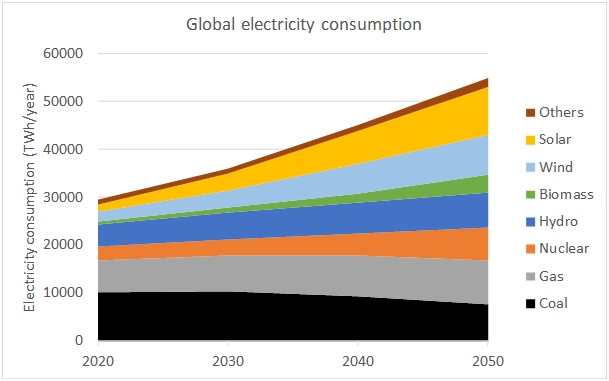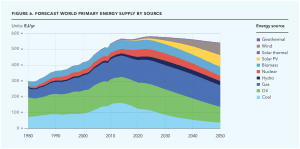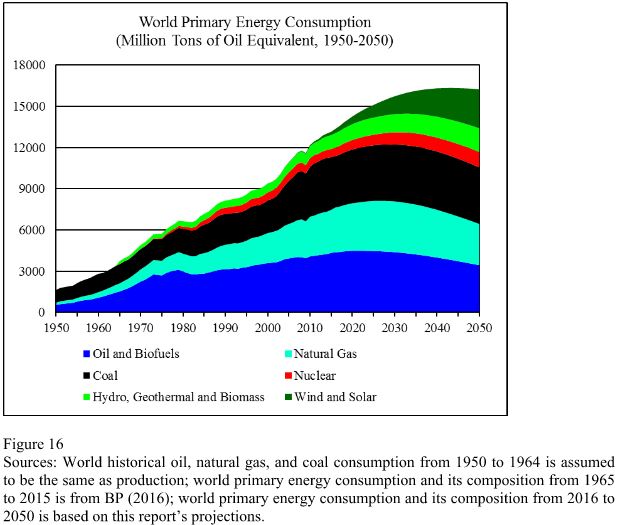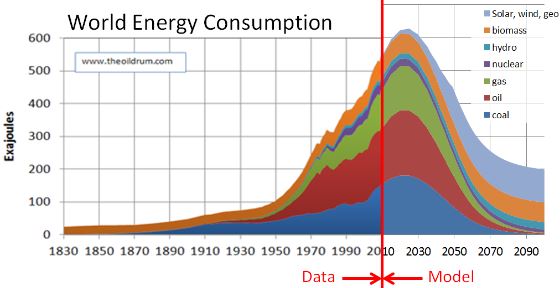Solar = A BRIGHT Future
Global RISE of Solar Energy

The below scenarios of global energy generation (global energy generation from ALL sources) show solar energy growing substantially (to slightly more or less than ¼ of total global energy supply depending on how optimistic the reference case used is).
Looking at just renewables globally, solar power will provide half (to over half) of renewable energy generation worldwide by 2050.
The rise of solar in the United States has been especially dramatic, as described in this brief snippet-
"The United States is on track to top 3 million solar PV installations this year, adding 1 million photovoltaic panels in just two years, according to a study by Wood Mackenzie Power & Renewables and the Solar Energy Industries Association. The number will exceed 4 million in 2023, the study says.
It took more than 40 years for the first million installations. “The rapid growth in the solar industry has completely reshaped the energy conversation in this country,” said Abigail Ross Hopper, SEIA president and CEO, in a press release announcing the study. The 2.7 million solar systems installed through September 2020 have the capacity to generate nearly 89 gigawatts of electricity. The solar industry employs about 250,000 Americans, the SEIA says." FROM - chooseenergy.com/solar-energy
The Energy Information Administration (EIA) forecast below depicts renewables supplying roughly half of the world’s electricity generation by mid-century. So, approximately half of the world's energy will be from renewables; and half of renewables will be solar = ¼ of the world's energy will be solar by 2050. Both solar and wind supply large portions of total global renewable energy amounting to the lion's share of renewable energy worldwide according to the EIA's optimistic forecast depicted below.
Wind has already experienced massive growth, and will continue to grow significantly; however solar energy has barely seen even a fraction of the exponential growth that solar will see in the coming decades.
The below scenarios suggest solar will provide ¼ of the world’s electricity needs; as utility-scale solar continues to drop in price, and solar photovoltaics continue to increase in efficiency - factors contributing to the future growth of solar. The following global energy mix scenarios, following the EIA’s outlook below, all have solar growing exponentially as mid-century approaches.
Although the EIA International Energy Outlook is often criticized (for underestimating the future growth of solar and wind, for example); the EIA Energy Outlook data compiled annually is often a starting point for many energy industry prognosticators nonetheless. Examples are BP, the International Energy Agency (IEA), Exxon, BNEF, DNV GL, optimistic energy blogs; are mostly variations of EIA’s basic data (as seen in the last few global energy mix scenarios in this article).
EIA projects that renewables will provide nearly half of world electricity by 2050
Source: U.S. Energy Information Administration, International Energy Outlook - ”In 2018, 28% of global electricity was generated from renewable energy sources, most (96%) of which was produced from hydropower, wind, and solar technologies. In its International Energy Outlook 2019 (IEO2019), the U.S. Energy Information Administration (EIA) projects that renewables will collectively increase to 49% of global electricity generation by 2050. Of the top three renewable sources, EIA expects solar’s share of generation to grow the fastest and hydroelectric’s share to grow the slowest.
The chart below from Bloomberg New Energy Finance (BNEF) depicts the projected increase of solar to roughly 1/4 of global energy generation by 2050. A substantial increase in wind energy generation, and a decrease in all other major energy generation sources, is also in BNEF's outlook.
Wind and solar make up almost 50% of world electricity in 2050 – “50 by 50” – and help put the power sector on track for 2 degrees to at least 2030.
Note: in order for the global energy transition from fossil fuels to renewable energy to be expedited, carbon pricing, and a few other public policies to mitigate anthropogenic climate change, will be required. Climate policies are needed to effectively decrease fossil fuel production, and increase renewable energy generation.
These climate-friendly policies will need to be adopted by the vast majority of nations worldwide in order to significantly curb greenhouse gas emissions to a safer level for the planet; and for the energy transition to be fully realized. Please click these links>>> for a complete guide on public policies to fight climate change, and strategies to stabilize greenhouse gas emissions.
This scenario (from energypost.eu) is similar to the most optimistic outlook from the EIA:

--------
FROM- energypost.eu/an-independent-global-energy-forecast-to-2050
[Note- the above projections for energy consumption, and the below one for energy supply to 2050, do not have solar at quite a 25% global level. However, solar’s share of the world electricity mix is steadily growing in the EIA scenario; and it is reasonable to assume that with the continued growth of the solar energy market, and continued urban electrification, much of which will depend on solar + battery storage. Solar will represent at least ¼ of the world’s electricity share by mid-century.
Solar achieves a large share of global electricity production, even if it is not depicted in global energy consumption, which can include oil and biofuels for transportation.]
The below scenario from DNV GL depicts a realistic, optimistic, energy forecast. Here, ambitious public policies like carbon pricing are effective in both raising the share of renewables in the global energy mix AND lowering global energy demand and consumption. Other than carbon pricing, a mix of positive climate public policies and technological advancements/ mass adoption of sustainable technologies and sustainable political-social trends bring about the needed positive changes.
These positive advancements include electrification of most urban energy needs (such as replacing conventional HVAC units in buildings with heat pumps, use of smart meters with all buildings, other energy efficiency and green building strategies), electrification of industry, sustainable mass transit, and the adoption of electric vehicles in urban environments at a significantly high level.
In addition, these positive developments in energy transition ALL include increased energy efficiency; in part due to increased urban electrification, across all sectors (buildings, transportation, shipping, industry, manufacturing, and agriculture), which has the effect of reducing energy demand and consumption.
Here is an outlook on world energy from DNV GL's Energy Outlook to 2050-

The below energy scenario offers a depiction of a scenario where renewables grow considerably, and overall global energy demand also starts to dip; in this scenario, the decline in global energy demand is seen shortly before 2050. In this scenario, overall world energy demand and consumption decline as fossil fuel consumption declines. Even as global energy demand declines, the share of renewables in the world energy mix increases, and the demand for renewable energy rises through mid-century.

FROM- peakoilbarrel.com/world-energy
Lastly, here is an optimistic scenario that depicts global fossil fuel use phasing out completely from the world energy mix by the end of the century; and energy demand declining sharply before mid-century, even as consumption of renewables steadily rises all century.

